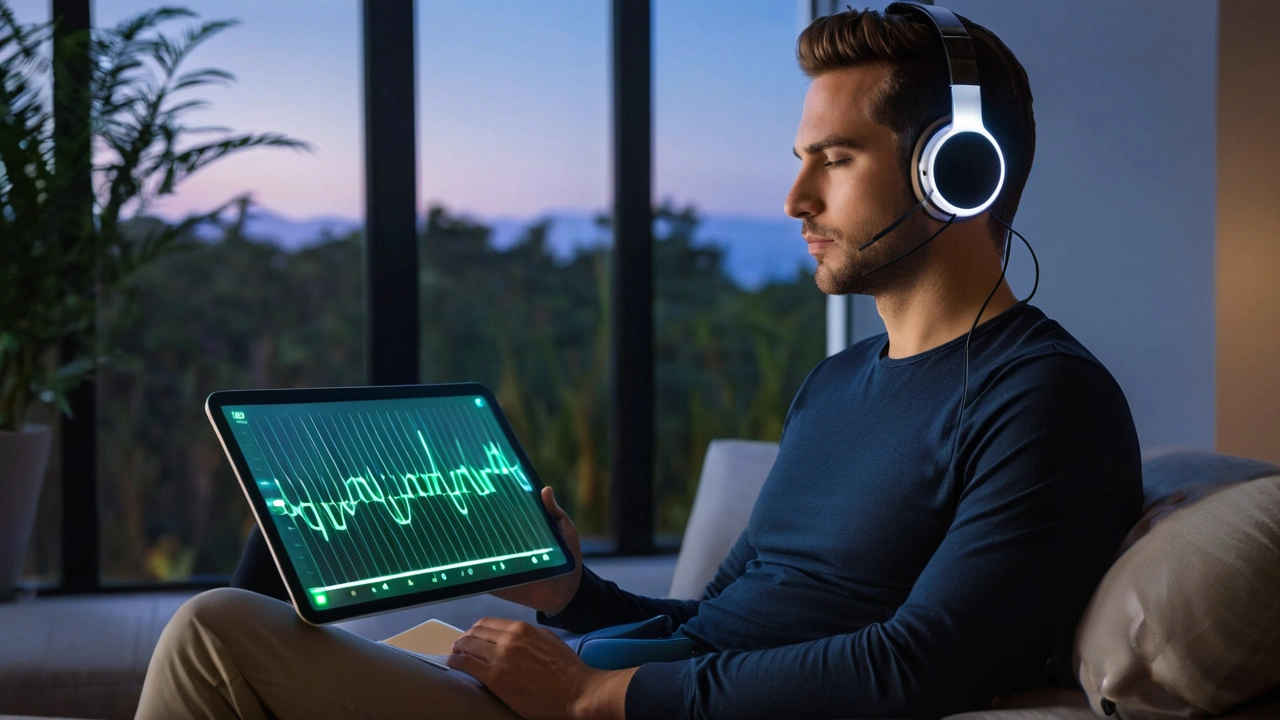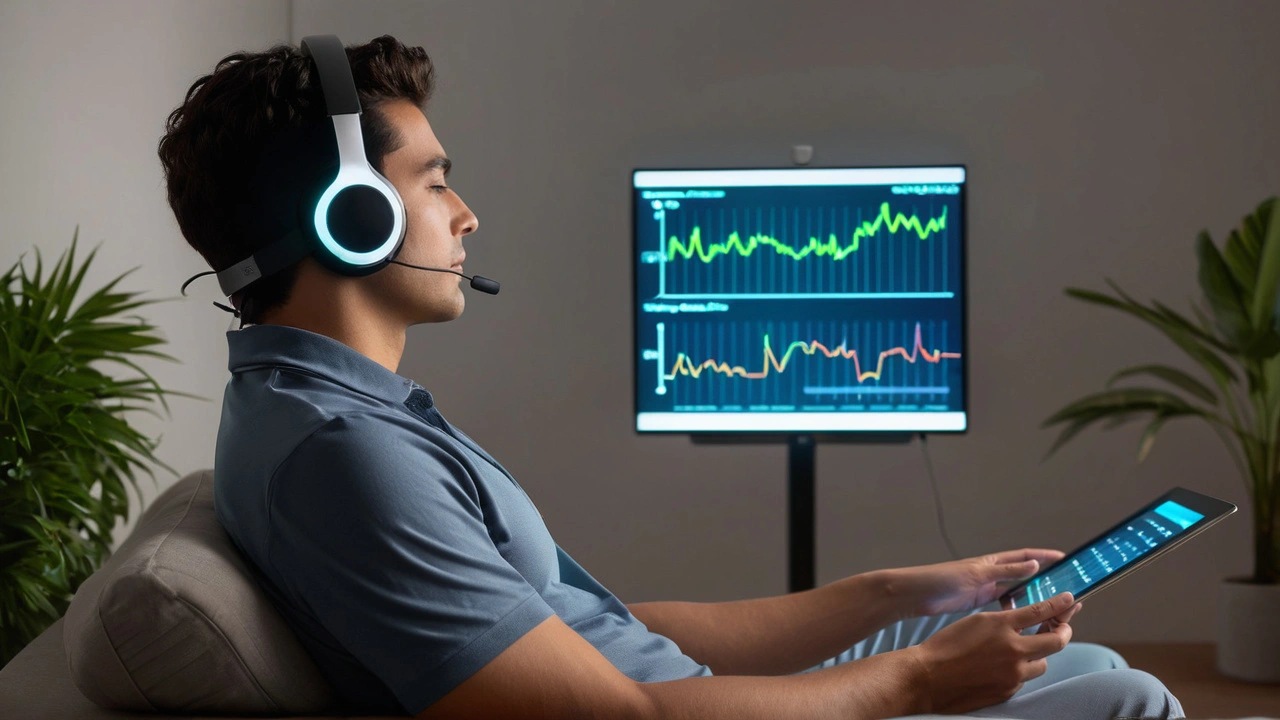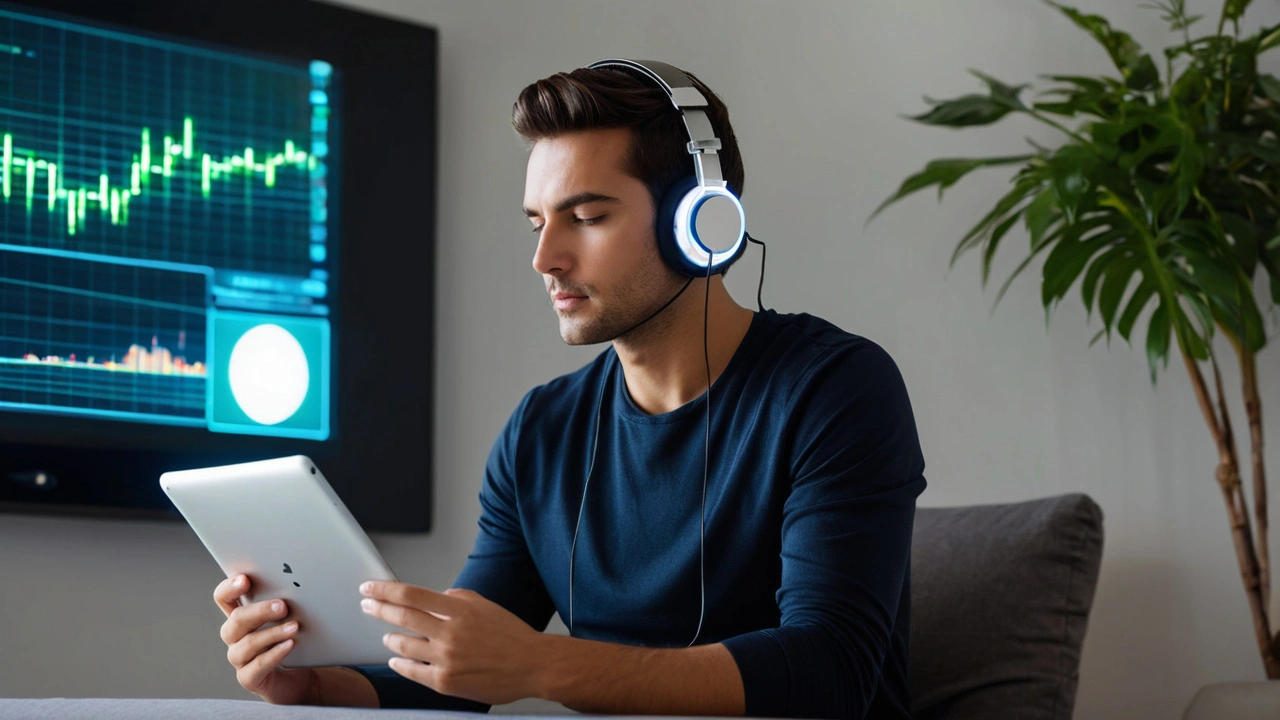In the quest for sharper minds and better mental health, biofeedback is emerging as a powerful tool. This technique taps into the natural signals of our bodies to enhance brain function.
Biofeedback involves using sensors to monitor physiological signals. These signals might include brain waves, heart rate, or muscle tension. By becoming aware of these processes, people can learn to control them, leading to improvements in mental performance and well-being.
- Understanding Biofeedback
- How Biofeedback Works
- Types of Biofeedback
- Benefits of Biofeedback on Brain Function
- Practical Tips for Using Biofeedback
- Real-Life Applications and Success Stories
Understanding Biofeedback
Biofeedback is a technique that teaches people how to control bodily processes that are typically involuntary, such as heart rate or muscle tension. By using various types of sensors, individuals can monitor their physiological functions in real-time. This insight allows them to learn how to regulate these functions, thereby improving their overall well-being and mental acuity.
One of the most fascinating aspects of biofeedback is how it directly involves the participant in their healing or optimization process. It's not just about observing data; it's about interacting with it. People use this feedback to practice self-regulation skills, a process which might involve slowing the heart rate through deep breathing or reducing muscle tension by visualizing a calming scenario.
Historically, biofeedback has its roots in the 1960s when researchers began exploring whether humans could consciously control their brain waves. They found that with the right training, people could indeed learn to modify their brain activity, which led to reduced anxiety and improved focus. Today, biofeedback is used for a variety of conditions, ranging from stress and anxiety to migraines and chronic pain.
Brain power is significantly influenced by stress levels, and biofeedback can effectively help manage this stress. When we become attuned to our physiological responses, we can anticipate and mitigate the effects of stress before they escalate. For example, someone using biofeedback may notice that their heart rate increases when stressed. They can then employ relaxation techniques to bring their heart rate down, preventing the negative cognitive impacts of prolonged stress.
"Biofeedback is a way for patients to understand their body's needs. It enables them to take control of their health in a way that medication alone cannot," says Dr. John Smith, a pioneer in biofeedback therapy.
Various forms of biofeedback are tailored to different functions. Electromyography (EMG) focuses on muscle tension, while electroencephalography (EEG) biofeedback, also known as neurofeedback, measures brain wave activity. Thermal biofeedback measures skin temperature, which correlates with blood flow, another indicator of stress levels.
Numerous studies have highlighted the benefits of biofeedback. According to the Association for Applied Psychophysiology and Biofeedback, up to 80% of people who practice biofeedback see improvements. This highlights the wide-reaching potential of biofeedback for enhancing mental and physical health.
How Biofeedback Works
Biofeedback is an intriguing intersection of technology and self-awareness that enables individuals to gain control over functions typically considered involuntary. Thinking of biofeedback, imagine a mirror that reflects not your outer appearance but your inner physiological processes. This mirror helps you recognize patterns, and with time and practice, you can learn to change them.
The process kicks off with attaching sensors to your skin. These sensors monitor a range of physiological signals, such as brain waves (using EEG), muscle tension (EMG), heart rate (EKG), skin temperature, and galvanic skin response, which measures the skin’s ability to conduct electricity. These metrics are then relayed to a monitor, giving you real-time feedback about your body’s state. This graphic or auditory feedback makes invisible processes visible and audible, which is quite transformative.
For instance, while watching a visual display of your heart rate, you might notice that it spikes when you think about a stressful event. A series of guided exercises can then help you learn to lower it through relaxation and breathing techniques. Over weeks and months of practice, your ability to control your heart rate could improve not just during sessions but throughout your day-to-day life.
Similarly, brain wave biofeedback, often called neurofeedback, takes it a step further by focusing on brain activity. This method can be particularly useful for treating conditions like ADHD, anxiety, and even migraines. Research has shown that specific patterns of brain waves are linked to these conditions. Through neurofeedback, individuals learn to encourage beneficial brain wave patterns and suppress those that cause problems.
"Biofeedback has a robust history of helping people manage stress and improve quality of life. It's like physical therapy for the brain," says Dr. Jane Bochner, a leading researcher in the field.
Neurofeedback usually involves a set of exercises, often in the form of interactive games or guided animations. When your brain produces the desired wave pattern, you receive positive feedback, which reinforces that state. Over time, this positive reinforcement helps you learn to naturally maintain these beneficial patterns.
Another method is thermal biofeedback, which gives feedback on skin temperature. Typically, warmer fingers are a sign of relaxation and health due to better blood flow, whereas colder fingers can indicate stress. Some biofeedback devices focus on muscular activity, allowing individuals to lessen tension and alleviate related aches and pains by teaching them to identify and relax specific muscle groups.
Ultimately, biofeedback is a wonderful blend of mind and machine. It empowers individuals to tap into their hidden potentials and make conscious changes for a healthier, more balanced life. Leveraging this tool effectively provides a powerful means to address various psychological and physiological issues without relying solely on medication.

Types of Biofeedback
Biofeedback comes in several forms, each targeting different physiological functions to help enhance brain power, mental clarity, or overall well-being. Let's explore some of these methods.
EEG Biofeedback
EEG biofeedback, also known as neurofeedback, focuses on monitoring brain waves. Through this technique, electrodes are placed on the scalp to record electrical activity. This data is then displayed in real-time, allowing individuals to learn how to regulate their brainwaves. It is commonly used for treating conditions like ADHD, anxiety, and insomnia. Various studies have shown positive results, with individuals experiencing improved focus and reduced symptoms of their conditions.
Heart Rate Variability (HRV) Biofeedback
HRV biofeedback measures the time variation between heartbeats, an indicator of autonomic nervous system function. By practicing HRV biofeedback techniques, people can learn to control their heart rate through deep breathing exercises and stress management strategies. A well-regulated heart rate is associated with better emotional regulation and cognitive performance. This method is particularly beneficial for those dealing with chronic stress and anxiety. It is also popular among athletes looking to optimize their performance.
EMG Biofeedback
Electromyography (EMG) biofeedback measures muscle activity. Sensors are placed on the skin to monitor muscle contractions with the goal of teaching individuals how to reduce tension and manage pain. This form is particularly useful for those experiencing tension headaches, chronic pain, or recovering from injury. By learning to consciously relax specific muscles, individuals can alleviate symptoms and improve physical function.
Temperature Biofeedback
Temperature biofeedback involves monitoring skin temperature to help individuals manage stress and anxiety. When stressed, the body responds by constricting blood vessels, reducing skin temperature. By learning to control their body temperature, individuals can manage their stress levels more effectively. Techniques often involve imagery and relaxation exercises. The practice has been beneficial for those suffering from migraines or Raynaud's disease, a condition affecting blood flow to certain parts of the body.
Galvanic Skin Response (GSR) Biofeedback
GSR biofeedback measures the electrical conductance of the skin, which varies with its moisture level. This method is often used in conjunction with other types to provide a more comprehensive understanding of an individual's physiological state. GSR biofeedback is primarily used for managing anxiety and monitoring emotional arousal. It has found applications in stress reduction programs and behavioral therapies, offering real-time data that individuals can use to adjust their emotional responses.
Respiration Biofeedback
This type focuses on breathing patterns and teaches individuals how to control their respiration rate. Irregular breathing can contribute to stress and anxiety. By learning to take deep, regular breaths, individuals can promote relaxation and improve oxygenation of the brain. This method is often combined with HRV biofeedback for a more holistic approach to stress management and cognitive enhancement.
| Type of Biofeedback | Main Use |
|---|---|
| EEG | Brainwave regulation |
| HRV | Heart rate control |
| EMG | Muscle tension reduction |
| Temperature | Stress and anxiety management |
| GSR | Emotional arousal monitoring |
| Respiration | Breathing pattern regulation |
As Dr. Paul Lehrer, a pioneer in HRV biofeedback, notes, "By understanding and influencing heart rate variability, individuals can achieve significant improvements in mental and emotional health."
Benefits of Biofeedback on Brain Function
Biofeedback is currently being hailed as a revolutionary technique to enhance brain function, and for good reasons. One of the most immediate benefits of biofeedback is its ability to help individuals manage stress. Chronic stress can be a major impediment to cognitive performance, affecting memory, focus, and decision-making abilities. By learning to control physiological responses to stress, people can improve their overall mental health.
An interesting fact is that biofeedback has been shown to help with conditions such as ADHD. A study published in the Journal of Attention Disorders found that children who used biofeedback showed significant improvements in attention and behavior. Parents and educators are turning to these techniques as non-invasive options to traditional medication.
Another important benefit is enhanced cognitive performance. Biofeedback can help individuals achieve a state of relaxation that is conducive to peak performance. Athletes, for instance, use these techniques to get into 'the zone' more consistently. When the mind is calm yet alert, it can perform complex tasks more efficiently.
Let's not forget about improved mental clarity. People who practice biofeedback report feeling more clear-headed and focused. This can be especially useful for professionals who face demanding workloads. By training the mind to maintain focus, productivity can see a significant boost.
Moreover, biofeedback contributes to better sleep. Poor sleep is often linked to cognitive decline and poor mental health. By practicing biofeedback techniques, people can improve sleep quality, which, in turn, enhances brain function. Research from the National Institutes of Health supports this, indicating that biofeedback can lead to substantial improvements in sleep quality and duration.
In some cases, biofeedback has been shown to help with mood regulation. This is critical for individuals suffering from anxiety or depression. By controlling the physiological symptoms of these conditions, such as rapid heart rate and shallow breathing, people can find relief from their mental stress.
"Biofeedback offers a unique way for individuals to gain mastery over their mental and physical well-being," says Dr. Richard Gevirtz, a leading expert in the field.
Finally, biofeedback is beneficial in reducing the frequency and severity of migraines. Studies show that those who engage in biofeedback techniques often report fewer migraines and other types of headaches. This provides a holistic approach to health management, targeting both body and mind.

Practical Tips for Using Biofeedback
Embarking on the journey of biofeedback can be both intriguing and rewarding. This technique offers several ways to enhance brain power and manage stress. To get started with biofeedback, it's essential to equip yourself with the right tools and knowledge. Begin by choosing a biofeedback device that suits your needs. There are many options available, from wearable gadgets to more sophisticated machines used in clinics. Some of the popular devices include heart rate variability monitors, electroencephalogram (EEG) headsets, and galvanic skin response sensors.
Once you have your biofeedback device, it's time to set up a conducive environment for your sessions. Find a quiet space where you won't be disturbed. The key here is to create a setting that promotes relaxation and concentration. Dim the lights, play some calming music, or use an essential oil diffuser. The aim is to ensure you're in a space where you can easily focus on the feedback signals from your device without external interruptions.
Start with short sessions to get the hang of the process. Fifteen to twenty minutes is a good duration for beginners. Pay close attention to the signals your body is sending. If you're using an EEG headset, you might be monitoring your brain waves. For a heart rate variability monitor, you'll be observing changes in your pulse. The feedback you receive will guide you to make appropriate adjustments in real-time. This might include deep breathing, focusing your mind, or relaxing specific muscle groups.
As Dr. John Doe from the Mayo Clinic states, "Biofeedback can often be the missing link in a person's treatment plan, offering insights that are not easily achieved through other means."
Next, consistency is the cornerstone of success with biofeedback. Regular practice can help reinforce the connections between your mind and body. Aim to incorporate biofeedback sessions into your daily routine. Some people find it beneficial to do a session first thing in the morning to set a positive tone for the day, while others prefer it in the evening to wind down and relax.
Tracking your progress is equally important. Maintain a journal where you can record your sessions. Note down what techniques you used and how you felt before and after the session. This will help you identify what works best for you and make necessary adjustments. Over time, you may notice patterns that give you deeper insights into how your mind and body interact.
Harnessing Biofeedback in Everyday Life
Applying biofeedback techniques in daily activities can further enhance its benefits. If you're someone who finds public speaking nerve-wracking, try a quick biofeedback session before stepping onto the stage. Monitoring your heart rate and practicing relaxation techniques can make a big difference in your performance. The same applies to stressful meetings or important exams. Using biofeedback in these moments can help you maintain calm and focus, leading to better outcomes.
Last but not least, don't hesitate to seek guidance from professionals. Biofeedback therapists can offer valuable insights and personalized techniques. Whether you're dealing with anxiety, chronic pain, or simply want to boost your cognitive abilities, professional help can tailor the biofeedback process to your specific needs. Remember, the science of biofeedback is ever-evolving, and new findings continue to improve and refine these techniques.
Real-Life Applications and Success Stories
Biofeedback isn’t just a theoretical concept; it's being used in practical, everyday life to make substantial improvements in mental well-being and cognitive functions. One field where biofeedback has garnered much attention is sports. Athletes like Olympic gold medalist Lindsey Vonn have leveraged biofeedback techniques to sharpen their focus and manage stress, resulting in improved performance. Vonn, for instance, has said, "Biofeedback has been a game-changer in helping me stay composed under pressure."
Beyond sports, biofeedback has made its way into educational settings to aid students. Teachers and educational therapists use it to help kids with ADHD and anxiety disorders. For example, a study conducted at the University of California found that students participating in biofeedback showed significant improvements in their attention span and reduced anxiety levels. Schools are beginning to implement these techniques to create more supportive learning environments, demonstrating the versatility and broad application of the method.
Medical Breakthroughs
The medical industry has also seen considerable benefits from biofeedback. Doctors are now incorporating these techniques to help patients manage chronic pain, migraines, and even hypertension. By becoming aware of their physiological responses, patients can learn to lower their heart rates and relax their muscles, which significantly reduces pain and discomfort. A well-known success story involves actress Cameron Diaz, who has spoken openly about using biofeedback to combat her chronic migraines, resulting in fewer episodes and a better quality of life.
Biofeedback gave me the tools to control a condition I thought would always control me. — Cameron Diaz
Workplace Stress Management
In today's fast-paced world, workplace stress is a common issue. Companies are starting to introduce biofeedback sessions as part of their employee wellness programs to help reduce stress and increase productivity. Major corporations like Google offer biofeedback sessions, where employees learn to manage their stress through breathing exercises and mindfulness, tracked by biofeedback sensors. These programs have shown to not only enhance employee well-being but also boost company's productivity levels. Employees report feeling more in control of their emotional responses, which leads to a more positive and productive work environment.
These real-life examples underpin the potential of biofeedback as a valuable tool in various settings. Whether you're an athlete seeking peak performance, a student needing better focus, a patient managing health issues, or an employee dealing with job stress, biofeedback offers tangible benefits. Its increasing adoption across different domains is a testament to its efficacy and versatility. The growing body of success stories makes it evident that biofeedback is more than just a trend—it's a change in the way we understand and harness our body's potential.
